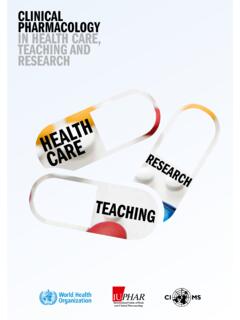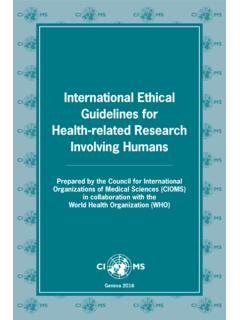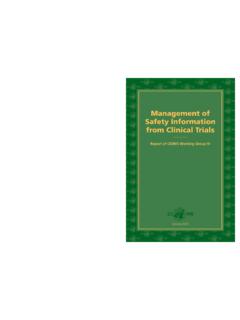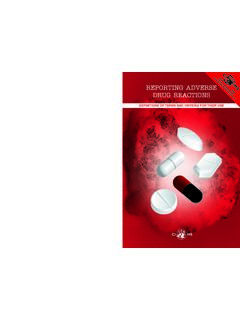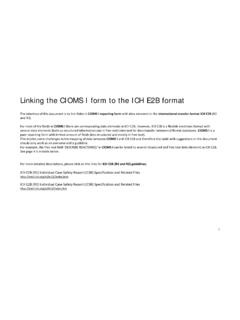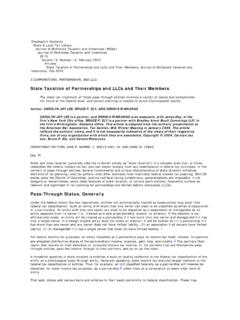Transcription of Drug-induced liver injury (DILI) - CIOMS
1 Drug-induced liver injury (DILI): Current status and future directions for drug development and the post-market settingA consensus by a CIOMS Working GroupCouncil for International Organizations of Medical Sciences ( CIOMS )Geneva 2020 Drug-induced liver injury (DILI): Current status and future directions for drug development and the post-market settingA consensus by a CIOMS Working GroupCouncil for International Organizations of Medical Sciences ( CIOMS )Geneva 2020 Copyright 2020 by the Council for International Organizations of Medical Sciences ( CIOMS ) ISBN: 978-929036099-5 All rights reserved. CIOMS publications may be obtained directly from CIOMS through its publications e-module at Further information can be obtained from CIOMS , Box 2100, CH-1211 Geneva 2, Switzerland, tel.
2 : +41 22 791 6497, , e-mail: CIOMS publications are also available through the World Health Organization, WHO Press, 20 Avenue Appia, CH-1211 Geneva 27, Switzerland. This publication is freely available on the CIOMS website at: Suggested citation: Drug-induced liver injury (DILI): Current status and future directions for drug development and the post-market setting. A consensus by a CIOMS Working Group. Geneva, Switzerland: Council for International Organizations of Medical Sciences ( CIOMS ), 2020. Note on style: This publication uses the World Health Organization s WHO style guide, 2nd Edition, 2013 (WHO/KMS/ ) wherever possible for spelling, punctuation, terminology and formatting. The WHO style guide combines British and American English conventions.
3 Disclaimer: The authors alone are responsible for the views expressed in this publication, and those views do not necessarily represent the decisions, policies or views of their respective institutions or companies. Design: Paprika (Annecy, France) CIOMS WORKING GROUP ON Drug-induced liver injury (DILI): CONSENSUS REPORT iii ACKNOWLEDGEMENTS CIOMS gratefully acknowledges the generous support from drug regulatory authorities, industry and other organizations and institutions which, by making available their experts and resources, facilitated the work that resulted in this publication. CIOMS is indebted to the international group of scientists who were part of the CIOMS Drug-induced liver injury (DILI) Working Group for their contributions to this consensus report.
4 The group members participated actively in the discussions and in the drafting and re-drafting of the report sections, enabling the Working Group to bring this major project to a successful conclusion. Special thanks go to Dr Herv Le Lou t, President of CIOMS , who initiated the idea of setting up this CIOMS Working Group. He had a leading role in this project from the stage of its conception. The Working Group was efficiently guided through its meetings by co-chairs Drs Herv Le Lou t, Arie Regev and Raul J Andrade. CIOMS thanks especially the three sub-group leads, Drs Einar S Bj rnsson, Robert J Fontana and Arie Regev, who facilitated the work of the sub-groups that produced the first draft versions of the different chapters and appendices of this report, and Dr Mark I Avigan, who provided a regulatory scientific perspective throughout the project.
5 We also wish to acknowledge Drs M Isabel Lucena and Michael Merz, who acted as rapporteurs for several Working Group meetings. The Editorial Team, comprising Drs Raul J Andrade, Mark I Avigan, Einar S Bj rnsson, Robert J Fontana, Arie Regev, and Ms Monika Zweygarth, merits a very special mention and thanks. The hard work and high commitment of this team was exceptional. At CIOMS , Dr Lembit R go, Ms Monika Zweygarth and Ms Sue le Roux managed the project. CIOMS wishes to acknowledge separately Ms Monika Zweygarth for her outstanding technical collaboration support, coordination and editorial work. Finally, we wish to acknowledge the support from the European Cooperation in Science & Technology (COST) Action CA17112 Prospective European Drug-induced liver injury Network and the participation of its members Drs Guruprasad P Aithal, Raul J Andrade, Einar S Bj rnsson, Gerd A Kullak-Ublick, M Isabel Lucena and Michael Merz in the CIOMS DILI Working Group.
6 Geneva, Switzerland, June 2020 Dr Lembit R go, MD, PhD Professor Herv Le Lou t Secretary-General, CIOMS President, CIOMS CIOMS WORKING GROUP ON Drug-induced liver injury (DILI): CONSENSUS REPORT v TABLE OF CONTENTS ACKNOWLEDGEMENTS ..iii TABLE OF CONTENTS ..v SUPPLEMENTAL APPENDICES .. vi TABLES AND vii READER S GUIDE .. vii ABBREVIATIONS AND ACRONYMS .. ix FOREWORD .. xii INTRODUCTION ..1 CHAPTER 1. WHAT IS DILI? ..3 DILI classification .. 3 DILI case definition and severity grading .. 8 Estimated DILI incidence and risk factors in the general population .. 11 CHAPTER 2. ASSESSING DILI CASES .. 17 Standard serum liver tests .. 17 Identifying and characterizing DILI in clinical trials .. 21 DILI case evaluation and minimum required data in clinical 26 Causality assessment.
7 32 liver biopsy for assessment of DILI diagnosis and prognosis .. 37 CHAPTER 3. EVALUATING DILI RISK IN DRUG 39 Role of pre-clinical assays .. 39 Data analysis in clinical 42 Considerations regarding collection and storage of clinical samples .. 49 CHAPTER 4. NEW liver SAFETY BIOMARKERS .. 53 Regulatory concepts .. 53 Biomarker performance and requirements .. 57 New exploratory biomarkers and approaches .. 61 CHAPTER 5. POST-MARKETING SURVEILLANCE FOR DILI .. 67 Rationale and challenges .. 68 Sources of data .. 68 DILI registries .. 73 CHAPTER 6. CLINICAL CARE .. 77 Monitoring standard serum liver tests in patients on hepatotoxic drugs .. 77 Clinical management of DILI .. 79 liver injury in cancer patients.
8 81 liver injury in patients treated with anti-tuberculosis chemotherapies .. 91 liver injury in patients treated with antiretrovirals .. 94 CHAPTER 7. DILI RISK MANAGEMENT AND COMMUNICATION .. 97 DILI risk management .. 97 Publicly available information on medicines and DILI risk .. 102 CIOMS WORKING GROUP ON Drug-induced liver injury (DILI): CONSENSUS REPORT vi CHAPTER 8. liver injury ATTRIBUTED TO HERBAL AND DIETARY SUPPLEMENTS .. 103 Introduction .. 104 Potential risk factors for HDS-induced liver injury .. 104 Improving detection and management of HDS-induced liver injury .. 106 Causality assessment of HDS-induced liver injury .. 108 Risk prevention and management of HDS-induced liver 108 Conclusion .. 109 REFERENCES.
9 111 APPENDIX 1. 135 APPENDIX 2. CASE REPORT FORM FOR HEPATIC EVENT .. 143 APPENDIX 3. DILI CASE NARRATIVES .. 153 APPENDIX 4. MEMBERSHIP AND MEETINGS OF THE CIOMS DILI WORKING GROUP .. 159 SUPPLEMENTAL APPENDICES Online only freely available on the CIOMS website at: APPENDIX 5 Data analysis for DILI assessment: Supplemental figures APPENDIX 6 Genetic susceptibility loci for DILI identified in GWAS and candidate gene studies APPENDIX 7 DILI registries and epidemiological studies APPENDIX 8 Information on DILI risks shown in product information of selected drug classes Anti-cancer drugs Tuberculosis chemotherapies Antiretrovirals APPENDIX 9 Differences in label safety information on hepatotoxicity: Two examples APPENDIX 10 Example of a causality assessment process for HDS-induced liver injury .
10 The algorithm used in China APPENDIX 11 Post-publication updates CIOMS WORKING GROUP ON Drug-induced liver injury (DILI): CONSENSUS REPORT vii TABLES AND FIGURES Table 1. General categories of DILI .. 4 Table 2. DILI clinicopathological phenotypes and examples of associated drugs .. 5 Table 3. DILI severity grading scales .. 10 Table 4. Drugs assessed for hepatotoxicity in the United Kingdom General Practice Research Database (GPRD) .. 12 Table 5. Number of DILI cases identified during a two-year period in Iceland .. 13 Table 6. Commonly used standard serum liver tests .. 18 Table 7. Diagnostic work-up to exclude alternative etiologies of DILI .. 28 Table 8. Assessment of DILI mechanisms in preclinical models .. 40 Figure 1. eDISH plot.
